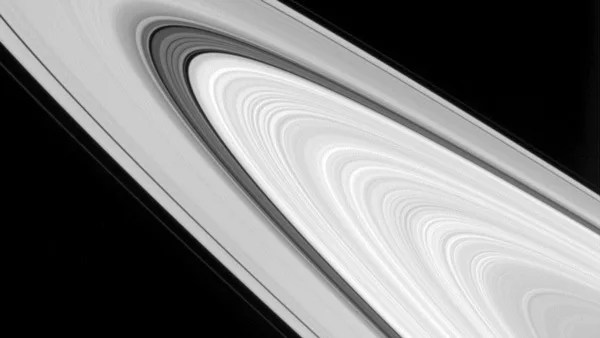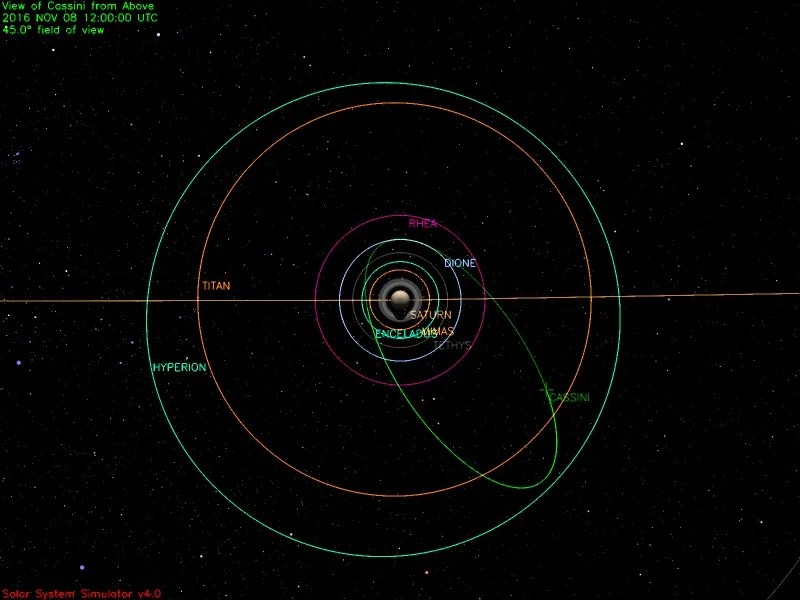6 min read

In December 2010, an amateur astronomer in Australia alerted the scientific community to a storm erupting in Saturn's northern hemisphere. Since 1876 astronomers have been seeing storms like this one only once during each Saturn year (about 29.5 Earth years). The 2010 sighting meant that Saturn's big convective eruption was happening early, and very fortuitously during Cassini's tenure. Right away, Cassini's scientists and engineers placed "storm-watch" observations in each of the command sequences for the spacecraft's upcoming observations. Regular readers of this report will recognize that at selected times when Cassini was already scheduled to point its optical instruments at or near Saturn, the Imaging Science Subsystem (ISS) would watch the storm for two minutes, often with the Visible and Infrared Mapping Spectrometer (VIMS) participating.
Cassini observed the composition, properties, and behavior of material surfacing from much deeper within the gas giant. The robot observatory witnessed this event from a front-row seat, even after the storm had wrapped its tail around the whole planet, and then faded away. Many more images remain to be taken of Saturn during the remainder of the mission, but on Monday of this week Cassini made its final, dedicated, two-minute storm-watch observation.
Wednesday, Nov. 2 (DOY 307)
Cassini turned to point ISS to the unlit side of Saturn's rings for 2.3 hours, to track and detect propeller-shaped features (http://go.nasa.gov/17oqTWF). The Composite Infrared Spectrometer (CIRS) and the Ultraviolet Imaging Spectrograph (UVIS) rode along. "Riding along" means that an instrument acquires data, and storage space for the data has been allocated on board. Next, ISS spent five hours creating a radial mosaic of Saturn's A and B rings. The instrument used its complement of filters to generate a set of high-resolution color images. CIRS, UVIS, and VIMS rode along.
When these observations were done, CIRS pointed near the middle of the broad A ring for three hours, continuing the campaign to study composition and structure using moderate-resolution spectra.
Cassini then pointed its high-gain antenna toward Earth, turned off its usual digital-data telemetry downlink, and began to produce precise, clear tones for a Radio Science experiment. Upon receiving a continuous reference signal from Earth, the spacecraft transmitted beams of radio-frequency energy towards Earth at S-band (2 GHz), X-band (8 GHz), and Ka-band (32 GHz). Cassini then slowly passed behind Saturn's wide-open rings for four hours, with the radio beams actively probing the narrow F ring, and much of the A ring. All along, the signals were recorded on Earth for immediate and future study. Including baseline calibrations outside the rings, the experiment lasted 7.5 hours. Radio occultations like this one provide valuable scientific information about Saturn's rings at much longer wavelengths than the stellar and solar occultations that the Optical Remote-Sensing (ORS) instruments observe.
Thursday, Nov. 3 (DOY 308)
CIRS stared at the outer strands of Saturn's C ring for six hours, to study their composition and structure. The C-ring strands are the innermost easily-visible rings, although the very faint D ring is even closer to Saturn. VIMS and UVIS rode along. VIMS then observed a stellar occultation of the A ring as the bright red star alpha Orionis, also known as Betelgeuse, probed the ring from behind with its light. CIRS rode along for this 3.7-hour opportunity.
Finally today, ISS spent nearly two hours imaging the faint components of Saturn's ring system while they were sunlit at high phase angles. Observing at low opening angles helped maximize the contrast of these parts. The other ORS instruments, CIRS, VIMS, and UVIS, all rode along.
Friday, Nov. 4 (DOY 309)
First off today, ISS and VIMS made a two-minute storm-watch observation on Saturn. Then, while the rings were still mostly back-lit by the Sun, ISS spent ten hours, with CIRS and VIMS riding along, making a high-phase, low-elevation observation of the faint rings that lie outside the main ring system. Next, UVIS, CIRS and VIMS began a 19-hour joint observation of Saturn’s aurora.
Saturday, Nov. 5 (DOY 310)
For five hours today, VIMS observed the sunlit side of Saturn's rings. CIRS and UVIS rode along.
Sunday, Nov. 6 (DOY 311)
CIRS took the reins for 20 hours today. For the first eight hours, with UVIS riding along, the instrument obtained thermal-infrared spectra to study B-ring particle composition. The remainder was spent with ISS and VIMS riding along, on an observation of Saturn’s atmosphere to better understand its chemical composition.
Right at the end of the day, Cassini coasted through apoapsis, the slowest and highest point of the spacecraft's 9.6-day, highly inclined orbit of Saturn. This marked the beginning of Orbit #248.
Monday, Nov. 7 (DOY 312)
Today at 04:00 Universal Time Coordinated (UTC), ISS and VIMS finished making the Cassini mission's final two-minute Saturn storm-watch observation. SCET was 90.6 minutes from Earth Received time at this epoch. The digital telemetry-data playback from the observation was received by the 70-meter diameter DSN station in California later today, and was in the hands of the imaging science team shortly thereafter. This article from 2013 elaborates on the subject Saturn storm. /news/12753/nasas-cassini-watches-storm-choke-on-its-own-tail .
The Cassini weekly image showcases Saturn's rings in stunning details: /resources/17547/ .
Tuesday, Nov. 8 (DOY 313)
CIRS spent 10 hours creating a map of Saturn’s north-polar region, to study the temperature of the vortex that persists there.
The Deep Space Network (DSN) communicated with and tracked Cassini 10 times this week, using stations in Spain, Australia and California. A total of 160 individual commands were uplinked, and about 1,740 megabytes of telemetry data were downlinked and captured at rates as high as 110,601 bits per second.
Wrap up:
Cassini is orbiting Saturn with a period of 9.6 days in a plane inclined 57.9 degrees from the planet's equatorial plane. The most recent spacecraft tracking and telemetry data were obtained on Nov. 8, using one of the 34-meter diameter DSN stations in California. The spacecraft continues to be in an excellent state of health with all of its subsystems operating normally except for the instrument issues described at http://saturn.jpl.nasa.gov/anomalies .
Cassini's path up to mid-day Nov. 8 is illustrated here: http://go.nasa.gov/2epc2Br . At that time, the countdown clock in Mission Control was showing 310 days until the end of the mission.
Information on the present position and speed of the Cassini spacecraft may be found on the "Present Position" page at:http://saturn.jpl.nasa.gov/mission/presentposition .
An illustration of Cassini's path up to mid-day Nov. 8, 2016. At that time, the countdown clock in Mission Control was showing 310 days until the end of the mission.








